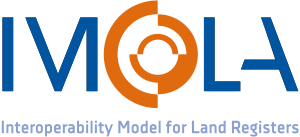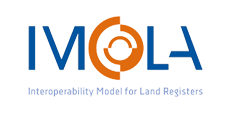IMOLA I

Background
There is a need for a standard means of accessing basic land registry information within the EU. Yet, the cross-border exchange of information between European land registries is complicated. Differences in national legislation and divergences inherent to the practice of land registration are the main causes of this complexity. Therefore, a need for a standard means of accessing basic land registry information within the EU, paired with the availability of explanatory material and the training of practitioners to improve the understanding of foreign legal systems, is evident.
Common points do exist and offer the possibility of defining a structure of key information shared by the majority of land registry systems. The IMOLA project, subsididised by the EC Civil Justice Programme, has performed in-depth research on these common key points, developing interoperability solutions that have made the differences understandable to the professionals participating in real estate transactions, and facilitate cooperation with other networks in order to contribute to the development of a European real estate and mortgage market.
The European Land Registry Association initiated the IMOLA-project with EULIS, the Colegio de Registradores de la Propiedad, Mercantiles y Bienes Muebles de España and the Dutch Kadaster.
Aims and Objectives
The project aimed to produce a model for standardised land registry output, connected to explanatory material in different languages, and to provide training to improve understanding of the different legal systems involved. The European Land Registry Association (ELRA) has worked closely with other associations and networks concerned in this area.
IMOLA’s global objective is to increase the accessibility and transparency of land registry information and to facilitate the registration of cross-border documents. Varied legislation and practices of Land Registries hamper the exchange of information between them and the registration of cross border documents. Any standard model has to take into account fundamental differences in national organisation. However, common points offer the possibility of defining a structure of key information shared by the majority of Land Registry systems.
Activities as an initial stage, different types of property rights and registration methods have been compared. Based on this comparative research, an analysis will take place and EU placeholder descriptions will be developed that could help to connect equivalent rights. The research has also included the conditions of access to the information of each country, particularly data protection policy, and the use of electronic communication.
The outcome is a draft of an interoperability framework, which was discussed in three conferences. Part of this framework is describing an XML language for Land Registers and development of a template for a E(uropean) L(and) R(egistry) D(ocument) to which the entering of XML-data could be computerized. The draft was presented to registrars, legal scientists and other key players on IMOLA Closing Conference held at Brussels on January 27th based on the comments received, the model will be updated.
Results of the project
- Guide lines for the establishment of standardised access to land registry information;
- Define a broker to unify the many national defined dictionaries, information models, protocols and output formats.
- Define a semantic model for a European Land Registry document (ELRD).
- The assistance tools complementing the single point of access within the e-Justice portal will enable an effective use of this information.
- Implement a publication engine that takes a request and formats the results in a standard predefined form.
- Training will ensure better mutual understanding between registrars and their staff and with other legal professional, in order to promote the smooth processing of foreign documents in Land Registers. In particular, as regards succession matters, it will facilitate best practice in translating foreign rights in rem into their nearest local equivalent.
The Main Achievement: European Land Register Document
IMOLA has reached a proof of concept of an ELRD (European Land Register Document) or template for organizing land register information at European level. This project has been based upon the following guidelines:
1. Judicial cooperation. ELRA consider that one of the main functions of the land register systems is to facilitate information intended for the legal purposes. Therefore, the paramount scope of the ELRD is judicial cooperation that European legislation is in fact requiring, as well as facilitating transactions of properties (mortgages, sales) by means of information of the legal status of the marketable properties.
2. Bottom-up. This legal information is based on a bottom up approach of the European LR systems (legal neutrality: not the imposition of one model of those existing in Europe). IMOLA approach suggests:
– Structure ABC of the information;
– Plurality of the land register units or properties;
– Ownership with attributes;
– Organization of the encumbrances on the properties including judicial restrictions.
– That is the result of efforts for mutual understanding between ELRN Contact Points and a complicate balance, given the extreme legal diversity in land registration.
3. Legal minimum. ELRD should contain sufficient legal information to provide an adequate idea on the legal status of the land register units or properties. Information is not useful if relevant aspects of it are omitted.
4. Flexibility. The idea was not very simplified information but a flexible model in order to include all relevant registry information. Omissions in legal information make it inconsistent. ELRD may be used and adapted by all European systems or the more the merrier.Every land register system could arrange information data on this scheme insofar they are available or disable those data fields not available, depending on the national specifics. Although ELRD is easier for title registration systems, deed registration systems may adapt information of the personal folio to the requirements of ELRD by means of the relation of deeds which it involves. ELRD may be a European guideline for land registries information given that it is based on mutual understanding or minimum shared by the network of contact Points (ELRN).
5. Reference Information. Reference information and Glossaries support ELRD in order to explain the use of the template and the comprehension of its legal terms.
6. Glossaries explain relevant placeholders. There must be a general glossary and also national glossaries in relation with the general one.
7. Reference information (RI) is devoted to explaining the meaning of the information more in detail, even in context. In IMOLA project ELRN have implemented 5 Reference Information Fact Sheets for these purposes (LR Unit (Section A), Propretorship (Section B), Encumbrances (Section C), Legal Value of LR Information and Legal effects of Registration.)
8. Semantic Model. ELRD has required a Semantic model based on:
– Placeholders (in English) and commonalities of LR information at European level (ELRA bottom-up approach);
– A Thesaurus, which becomes the cornerstone of the following developments of IMOLA;
– Features of e-Codex building blocks, which have to be taken into account.
These examples are the result of a proof of concept proposed by ELRA based on the information issued by the registration systems of the following countries:
Disclaimer: “The content of this page represents the views of the author only and is his/her sole responsibility. The European Commission does not accept any responsibility for use that may be made of the information it contains.”


